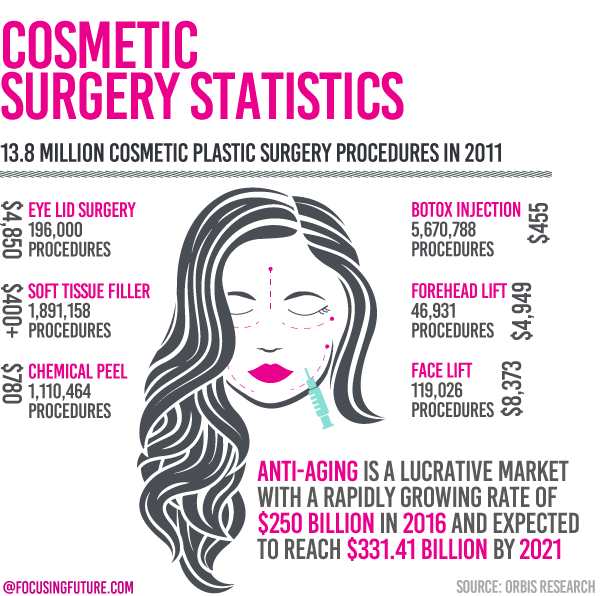![]() 4 minute read
4 minute read
Slowing down aging has always been one of the dilemmas for the humanity. Fixing cosmetic defects of getting old is now an affordable and quite popular procedure. With life-extension movement on the rise and longer life-cycle stages, anti-aging goes beyond physical health. Medicine to prevent internal changes and restore immune system is under the research. Moreover, the term of aging and perception of old shifts from age to the lifestyle. What will happen when the eternal life pill will be a reality?
Reducing cosmetic defects of aging
Originally, the anti-aging industry was majorly focused on reducing physical defects of getting old. The population is rapidly aging – in 2009, 13 % of American citizens were older than 65 years old, and this number is expected to increase to 19% by 2030. People are concerned about their wrinkles and general appearance, as looking young is always associated with being healthy and energetic. In 2011, 13.8 million cosmetic surgeries took place. The overall anti-aging market is expected to reach $331.41 billion by 2021. The most common aesthetics procedures include eyelid surgery, chemical peel, botox, and different kinds of face-lifts. Alas, these treatments only deal with physical consequences of aging whereas they do not retard aging processes.
A pill for eternal life
PureTech Health, an innovator from Boston, recently introduced drug molecules that revitalize aged immune cells with bacteria found on Easter Island. Many believe that aging is a genetic disease which could be edited. David Sinclair, a professor at Harvard Medical School, also agrees that aging issue can be resolved at DNA level. Supplying the organism with nicotinamide adenine dinucleotide, NAD+, can prevent people from aging and make them feel physically and mentally as 25 years-olds.“NAD+ is the closest we’ve gotten to a fountain of youth,” says David Sinclair. “It’s one of the most important molecules for life to exist, and without it, you’re dead in 30 seconds.” These research enable the future of slow-aging population where living long might be not as important as living well. Thus, the body would stay younger longer and the current aging pace would be reduced by 25%.
Age of 25 is the new 18
“25 is the new 18”, and modern “teenagers” are not in a rush to discover the joys of adulthood. “Living long and prosper” is the driving force for medical and antiaging spheres. These innovations truly comply with novel lifecycle stages, as people now need more time to get married, climb up the career ladder, and have children. Today, in EU on average women have their first child at age of 29. The term of getting old might not be necessarily global and shared between generations. Studies show that with every decade of life the “old age” moves to the next ten years. The age does not determine the aging, but the ability to perform does.
In Pew Research Center Social & Demographic Trends survey, 79% of respondents named age of 85 old, while next two characteristics are with 76% and 66% respectively are an inability to live independently and drive a car. Having grandchildren is an aging characteristic for younger generation while older individuals do not perceive it as such. Thus, the perception of “old” varies due to generation and social environment, not an actual number of years lived.
Dealing with neurological
and psychological symptoms of aging
Restoring and reversing aging from a DNA perspective is important, but dementia, Alzheimer disease, and other mental conditions still have prevalence among the elderly. In the UK, 1 in 14 people older than 65 has dementia and this number is expected to increase due to rapid aging. New technologies provide solutions for aging population and homecare. Different assistive technology like Google Glass and apps like Power Sleep help recognize faces, remind of taking medication, track people movements and control the housing remotely. Navigation for dementia patients sometimes is also hard, and policymakers and governmental authorities should couple up to create effective assistive technology for city dwellers with dementia. This will ease their communication and reduce the percentage of accidents. As a result, the progression of neurological aging and price of taking care of elderly will decrease leading to a safer environment and mentally stable society with equal opportunities for people of all ages.





